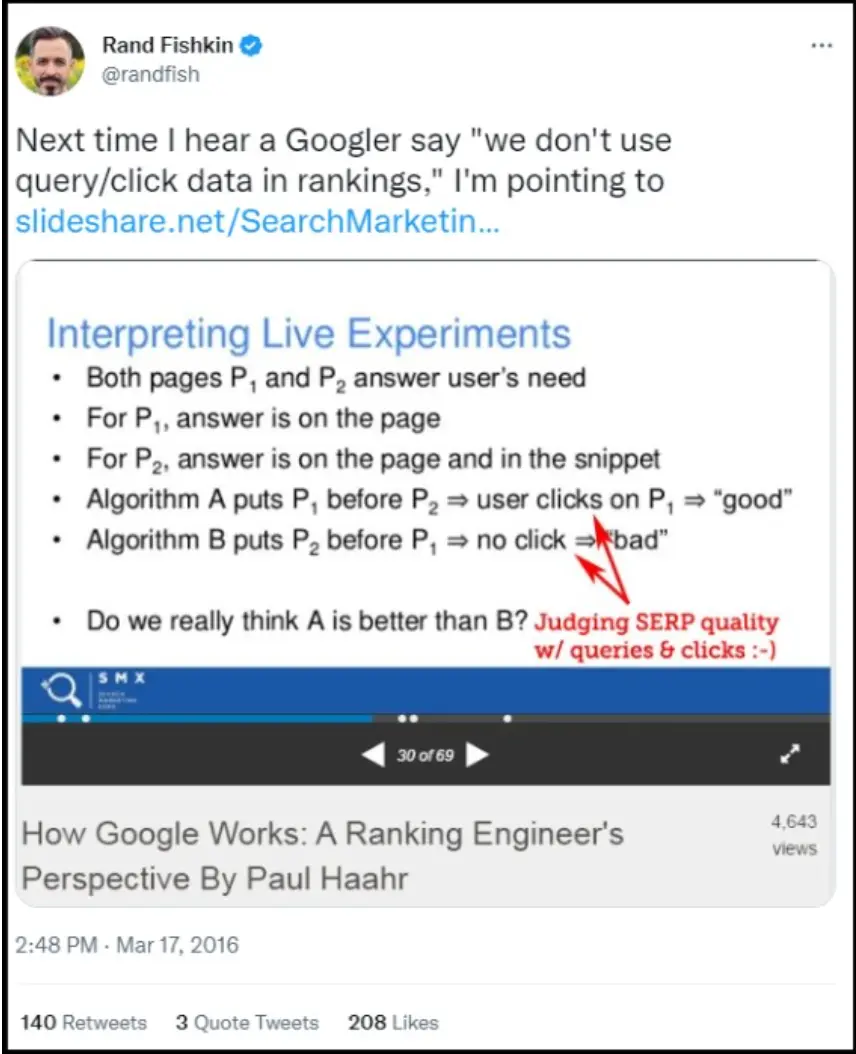Are you looking for a way to improve website traffic without having to rank higher on Google? If so, then CTR optimization is the answer. Click-through rate optimization involves tactics that encourage website visitors to click on your listings in search engine results pages.
*Update 02/12/2025
Optimizing CTR allows you to get more organic traffic and improve your SEO rankings simultaneously. It is a very important piece of the web presence optimization puzzle.
Shortcuts
- Work on Your Title Tags
- Use More Descriptive URLs
- Write Better Meta Descriptions
- Take Advantage of Rich Snippets

What is Organic CTR?
Organic CTR (click-through rate) is the percentage of people who clicked on a website's listing on a search engine results page compared to the total number of people who saw it.
It is an important metric used by SEOs and marketers to measure their content's effectiveness in visibility and engagement.
For example, if a website’s CTR is 10%, then 10 out of every 100 people who saw the listing clicked.
Why is CTR Important for SEO?
Optimizing CTR is important for SEO because it can help improve your website’s traffic by attracting people to click on your content.
Plus, Google looks at this metric as a sign of user engagement, and if it is higher than the average CTR for similar websites, it will likely rank your content higher.
In fact, according to Larry Kim's article at Moz, there is a clear connection between organic click-through rates and search engine rankings:

And if we dig deeper, look at the statement from an engineer at Google that Rand Fishkin tweeted:

We can read the Google experiments on how they judge the algorithm and the related ranking elements.
In short, thanks to RankBrain, Google can monitor organic click-through rates and gain valuable insight into what users prefer when searching on SERPs.
To corroborate this, look at this tweet by Danny Sullivan, Google's Search Public Liaison.

Danny stated, “Google is closely monitoring clicks to measure results quality.” To make a point, you want to maximize CTR by optimizing your content for organic search results.
1. Work on Your Title Tags
Title tags are the titles of a page that appear in search engine results, social media, or browser tabs. They look like this:

Title tags are an easy and effective way to boost your rankings on Google, as they indicate the content of your page.
Optimizing them can help search engines understand what it is about, so you receive more traffic. Title tags are a small but confirmed ranking factor.
In this video, Google's John Mueller details the topic at the 15:35 minute mark. Take advantage of his insights!
-
What makes a great title tag?
- Keep it concise: Your title tag should be concise so users can skim it. Ideally, keep your title tag under 60 characters, with essential words appearing first.
- Include your target keyword: Your title tag should include your target keyword. It signals to search engines what kind of content you provide, allowing them to place it in relevant searches.
Use title case: Title case means putting all the words in your title tag into capital letters, except for small words like “the” and “of.”
Focus on search intent: When writing title tags, it's crucial to think about search intent.
Avoid clickbait titles: Clickbait titles exaggerate or mislead readers about what’s in the content. They may promise something that needs to be covered in the content or be vague, leaving readers frustrated.
Sparkly emotion: Finally, titles should evoke emotion to improve click-through rates. Using powerful words like “amazing,” “incredible,” or “secret” can encourage people to click on your page more often.
Write for humans, not search engines: This is the best suggestion to keep in mind. Although you want to include keywords in your title tag for search engine optimization purposes, ensure it still reads well for humans.
Google gives some suggestions in the Search Central blog. You may want to read them!
2. Use More Descriptive URLs
Studies have indicated that a descriptive URL is essential - and its logic makes perfect sense.
For example, would you prefer to click on, https://blog.powr.io/how-to-set-up-an-online-order-form , or https://blog.powr.io/article-12345 ?
Clearly, the first URL is much more descriptive, giving visitors an idea of what they can expect from the page. So, what are the strategies to increase organic CTR?
-
How do you optimize a URL to be more descriptive?
- Make them short: Shorter URLs perform better. It is vital to ensure that it conveys what it is about in the fewest possible words.
- Add your keywords: Including relevant keywords in your URLs can help improve CTR, as users are likelier to click on a link containing their search query.
- Use shorteners: URL shorteners can make URLs easier to read and remember.
- Leverage branded links: Using branded links in your URLs can help increase CTR, as they make it easier for readers to recognize the source of the link and trust that it is safe to click.
- Avoid dates: Dated URLs can signal users that the content needs to be updated, making them less likely to click on it.
- Focus on your users: Ensure it is clear, concise, and descriptive so that users can understand what to expect from the page.
For example, if the original URL was example.com/this-is-a-long-url, you could use link shorteners to create a branded link, such as, exm.pl/shortlink.
3. Write Better Meta Descriptions
Meta descriptions provide a way of summarizing the content of your page and can be used to increase CTR. Out of all the SEO meta tags, they are second in terms of importance.
Are you aware that a meta description “can be used” by Google to show an informative summary of your web page in its search engine results pages (SERPs)?

To put it another way, Google doesn't always rely on the meta description supplied by a site owner when creating its snippets for result pages.
It often replaces it with a summary of what it believes is most relevant to a searcher's query. Therefore, it is essential to make sure that you provide a compelling description for each page of your website.
-
What make a meta description better?
- Make them concise: Meta descriptions should be no more than 155 characters and be clear, concise, and relevant to the page's content.
- Avoid keyword stuffing: It’s an amateur blogging mistake not to include your target keyword in your meta description. You definitely should.
- Use bucket brigades: Bucket brigades are short phrases that act as signposts for users, guiding them through your content.
- Focus on user intent: For example, if someone searches for “Italian restaurants near me,” a meta description like “Find the best Italian restaurant in town!” would be more effective than simply stating the business's name.
- Make them unique: Each web page should have a unique meta description. It helps search engines distinguish between the different pages of your site and gives them more information about each one.
- Add a CTA (Call-To-Action): Adding a call to action in your meta description can help increase CTR, as it encourages users to click on the link.
4. Take Advantage of Rich Snippets
Rich snippets are unique pieces of HTML code that provide more information about a page and its content.
They can help increase CTR by providing more details about the page, such as ratings, product prices, and reviews.
It's an intelligent way to make your listing stand out on SERPs.
It's great for traditional sites as well as e-commerce sites. Rich snippets can give your page if you’re promoting a real estate program, products for fitness, or affiliate software.
For example, if you are running a food website, you can use structured data to display customer ratings and reviews. It adds social proof, which helps build trust with your audience.

Studies have reported that structured markup can increase CTR by up to 30%. You should consider implementing rich snippets on your pages to boost your rankings and increase your site's traffic.
It's a great way to stand out from the competition and get the most visibility for your content. You can use rich snippets, such as product reviews, ratings, and videos, to help you get more clicks from visitors.
You can also indicate that your reviews are verified by directly linking to the review source. This Google feature can help improve organic and local search engine rankings as they create a better user experience.
-
How do I use rich snippets?
- Select rich snippet type: You must decide which type of rich snippet is best suited for your page. The most popular include ratings, recipes, reviews, events, and product listings.
- Implement structured data: Once you’ve selected the type of rich snippet you want to implement, you must use the appropriate schema.org markup code.
- Validate the markup: You can use Google's Structured Data Markup Helper tool to help you create and add rich snippets to your web pages. You must enter the URL of the page you want to markup and follow their guide.
Or, you can use the validator tool of Schema.org to verify and test your content for rich snippets.

It is also a good idea to create a thorough SEO monitoring strategy to keep an eye on how your (as well as your organic competitors') search snippets are changing and if there's more opportunity.
If all this looks too complicated, don't worry. If you run a website with WordPress, you can use plugins like Yoast or All in One Schema to help you easily add structured data to your pages.
Regardless of your approach, leveraging rich snippets can help improve your organic search rankings and CTR and boost conversions.
Final Words
Organic traffic is essential for any website, and leveraging CTR is one of the best ways to increase it without ranking higher on Google.
Following the tips mentioned in this article can drive more traffic to your website and maximize your click-through rate.
I recommend testing different strategies to determine what works best for you and then measuring the results.
Such strategies include A/B testing, website visitor recognition, content dynamic personalization tools, and other advanced methods for improving conversion rates and CTR.
Finally, keep an eye on Google's Search Essentials to ensure your pages are always up-to-date.
About the author:
Erik Emanuelli has been a passionate blogger in the online marketing game since 2010. Visit his website to learn more about SEO to get more leads for your business.


